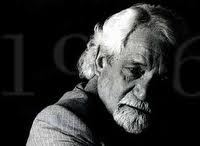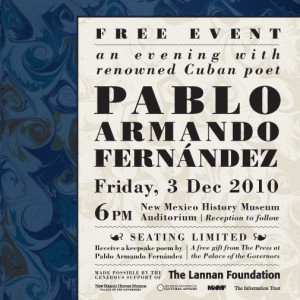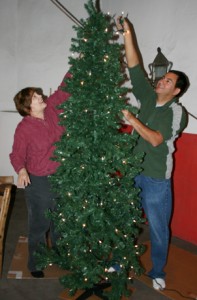
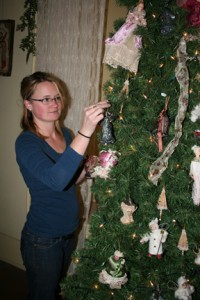 History Museum staffers morphed into Santa’s elves this week to doll up the 400-year-old Palace of the Governors for this Friday’s Christmas at the Palace event. (That’s Collection Manager and Registrar Wanda Edwards and NEH Project Manager Patrick Cruz workin’ the lights on a tree, at left; and their coworker, Assistant Collection Manager Pennie McBride, at right.)
History Museum staffers morphed into Santa’s elves this week to doll up the 400-year-old Palace of the Governors for this Friday’s Christmas at the Palace event. (That’s Collection Manager and Registrar Wanda Edwards and NEH Project Manager Patrick Cruz workin’ the lights on a tree, at left; and their coworker, Assistant Collection Manager Pennie McBride, at right.)
Over its 26 years as an annual event, Christmas at the Palace has become a community favorite in Santa Fe and, for many families, the true kick-off to the holiday season. The event begins with Native drummers beneath the Palace Portal, offering a welcome-to-the-Palace prayer. People gather to listen (and sometimes shiver as the snow falls) while awaiting the arrival of Mr. and Mrs. Claus and their clutch of real elves. Then everyone enters the Palace (no admission fees tonight!) to wander the exhibits, listen to local performers, sample bizcochitos and hot cider, and take a turn on Santa’s knee.
On Monday, workers pulled hay bales into the Palace Courtyard in preparation for Santa’s arrival. Garlands were hung over Palace doorways, trees were decorated, and more than a few trips up and down rather tall ladders were required.
 One of the favorite parts of the holiday decor is what Palace volunteers and staff think of as “Dee Johnson’s tree.” Before her untimely death, the former first lady of New Mexico gave the museum a collection of tree ornaments hand-crafted by New Mexico artisans.
One of the favorite parts of the holiday decor is what Palace volunteers and staff think of as “Dee Johnson’s tree.” Before her untimely death, the former first lady of New Mexico gave the museum a collection of tree ornaments hand-crafted by New Mexico artisans.
“It always makes us think of her when we see them,” said Museum Director Frances Levine. “Because she was so kind to the Museum staff — and so kind to donate these ornaments.”
Made of clay, tin, wood and fabric, they include Mimbres designs, Indian pots, bells, Zia symbols, stars and and more. In perhaps a nod to former Gov. Gary Johnson, a flying pig is included. (During particularly testy negotiations with the Democratic Legislature, the Republican governor once opened a news conference by playing with a remote-controlled flying-pig toy, as if to say, “When pigs fly…”)
Dee Johnson’s tree is in what we call “The Green Room” — the room to the east of the Palace’s main entrance where the architectural history of the building is detailed.
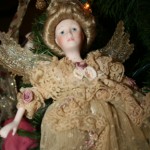 Other trees in the Palace include lovely Victorian ornaments, parrots and doves, reindeer, and a cathedral or two.
Other trees in the Palace include lovely Victorian ornaments, parrots and doves, reindeer, and a cathedral or two.
Bundle up the family and head to the Palace after work this Friday. The doors open at 5:30, but you can start gathering and enjoying your neighbors before then. Performers range from talented children to inspiring adults, including:
5:30-6 pm: Epik Artists of the Santa Fe Concert Association; music by Bach and Gounod. (The Epik Trio: Eric Illick and Sarah Rogowski, violins; Shelley Armer, viola. The Epik Chorus: Genevieve Davis, Alex Viszolay, Zoe Unverwerth, Faye Mathey, Sarah Luiz; Ezra Shcolnick, violin; Shelley Armer, viola; Logan Luiz and Eric Illick, soloists.)
5:30-6:30 pm: Coro de Agua Fria. Traditional Christmas carols in Spanish in the Palace Courtyard.
5:30-6:30 pm: Santa Fe Talent Education Suzuki Music Center. Classical and Christmas music by youth violinists and violists. (Uttam Khalsa, Auleeyah Archuleta, Bacilio Benelalija, Naya Anllo-Valdo, Madelyn Kingston, Sarah Sze, Julia Baca, Lila Baca, Ellie Bobchak. Margaret Carpenter, teacher.)
6:40-7:30 pm: The Eclectics. A cappella carols, medieval to modern. (Meg Acton, Laura Cowan and Scott Geister.)
6:40-7:30 pm: Schola Cantorum. Santa Fe’s sacred music ensemble.

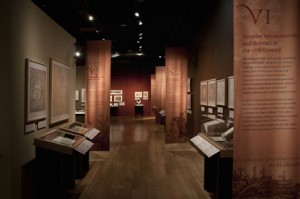 With the able help of UNM professors (Rebecca Sanchez, Mercedes Valenzuela and Ron Taylor) , the History Museum is proud to announce
With the able help of UNM professors (Rebecca Sanchez, Mercedes Valenzuela and Ron Taylor) , the History Museum is proud to announce 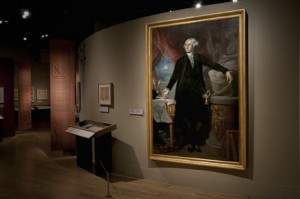 Many of us were taught how important France’s aid was to achieving U.S. independence, but far fewer know that Spain’s financial aid essentially underwrote the American Revolution.
Many of us were taught how important France’s aid was to achieving U.S. independence, but far fewer know that Spain’s financial aid essentially underwrote the American Revolution.